
Dan Feidt's log on Minnesota, Information Operations, spinstorms and latent contradictions.
"When I ran into the drugs I was told that if I mentioned the money to the drugs around 9/11 that would be the end of me."
--Indira Singh
The 9/11 terror plot itself, intersected with the activities of a drug trafficking network of international scope, in ways that form a "crystal clear" picture of what was going on -- to quote Sibel Edmonds.
Fintan Dunne, Editor BreakForNews.com (at this link, Daniel Ellsberg's support of Edmonds is noted - Ellsberg was cool on Colbert Report this week)
SIBEL: Essentially, there is only one investigation – a very big one, an all-inclusive one. Completely by chance, I, a lowly translator, stumbled over one piece of it. But I can tell you there are a lot of people involved, a lot of ranking officials, and a lot of illegal activities that include multi-billion-dollar drug-smuggling operations, black-market nuclear sales to terrorists and unsavory regimes, you name it. And of course a lot of people from abroad are involved. It's massive. So to do this investigation, to really do it, they will have to look into everything.
CD: But you can start from anywhere –
SIBEL: That's the beauty of it. You can start from the AIPAC angle. You can start from the Plame case. You can start from my case. They all end up going to the same place, and they revolve around the same nucleus of people. There may be a lot of them, but it is one group. And they are very dangerous for all of us.
Now THIS is what I call a map. This comes directly from the National Drug Intelligence Center in the Department of Justice, National Drug Threat Assessment 2006, January 2006. Today I'm going to post a lot of stuff that I certainly don't consider the Gospel Truth. It's purely for your careful consideration with barrels of salt. So let's kick things off with the DOJ:
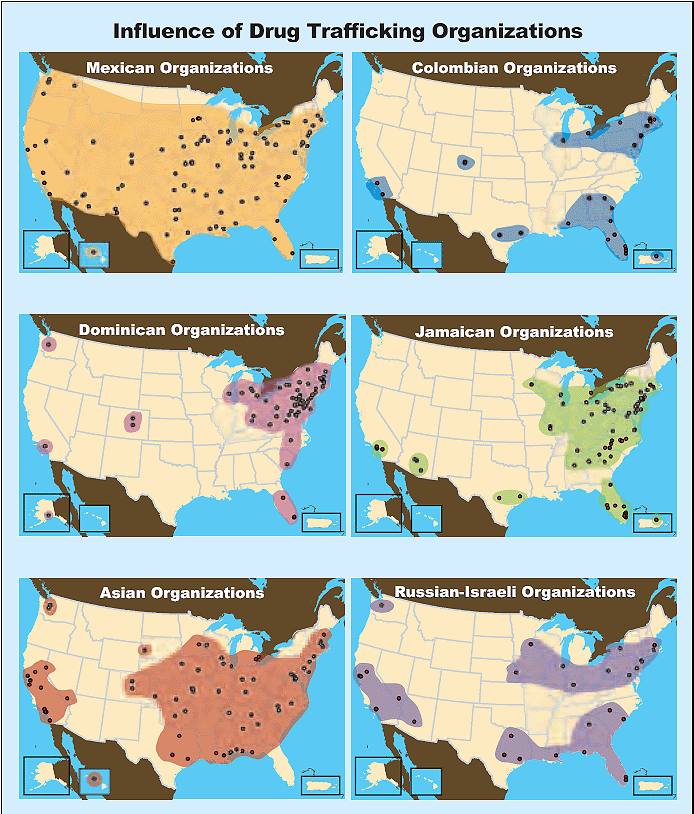
And this is just funny. I suspect the purple patches are notorious 'rebel zones' in the War on Drugs, where the federal and state government policies have split apart entirely. But they forgot eastern Tennessee... and of course everywhere else.

We will be returning to the one about the Russian-Israeli crime organizations. Florida drug money is connected to some of the loose ends around 9/11. The 9/11 drug money connection has many potential angles, but first note here that the DEA marks Miami as a key heroin and cocaine distribution area.
Now we're going into stuff that seems hard to believe, and beyond here, I don't claim that any of these people are telling the truth.
This is just a small slice of the material on the internet about how the rich & powerful skim huge amounts of cash out of the addicted masses of America through the profitable geopolitics of illicit drugs. Some people claim there is a strong connection between drug trafficking and 9/11 financing. Certainly all the players in Afghanistan since 1979 have been up to their ears in it, including the CIA and its favored contractors (who make up around half the CIA personnel these days).
This is certainly part of a trend towards the criminalization of war, which corresponds to the increasing privatization of war. We will have more on this angle in the coming days. Even if there are no operational links to the real September 11 conspiracy itself, the drug-militarization angle really needs to be investigated seriously, perhaps by a Democratic Congress with subpoena and immunity powers. Even snooping at possible loose 9/11 connections immediately reveals a world awash in drug money, with Bush and the Establishment generating vast cash flows from conflict zones - and enforcing loyalties among players from Afghanistan to South America by aligning these cash flows with military force. Sometimes privatized paramilitary forces. Why not?
 "Kill the Messenger:" Sibel Edmonds is on the radar a bit more than usual, as they have apparently whipped up a documentary to expose more of her surreal role in the weird world of intelligence after 9/11, named appropriately enough, Kill the Messenger. (perhaps she shouldn't be trusted, one guy suggests) A blog supporting Edmonds' film, sibeledmonds.blogspot.com is operated by Lukery at wotisitgood4.blogspot.com, who has covered her case in detail. To recap what I have posted before, Edmonds worked as a translator at the FBI, where she discovered a conspiracy within her unit to cover up a Turkish espionage ring in the United States. One of her co-translators was spoofing the wiretaps for FBI agents, and when Edmonds tried to bring this to her superiors, they suppressed the whole thing. Also Dennis Hastert was taking big bribes from the Turks, and there is some kind of global nuclear parts trafficking conspiracy connected to the AQ Khan network and some Israeli mobster types - probably Marc Rich type guys. The guys running the secret nuclear trafficking network were enemies of the CIA's Brewster-Jennings counter-proliferation operations and Valerie Plame, adding yet another twisted concourse to that scandal. And the AIPAC stuff and Chalabi are laterally related, since so much of it revolves around the same neo-con cats in DC and their foreign allies.
"Kill the Messenger:" Sibel Edmonds is on the radar a bit more than usual, as they have apparently whipped up a documentary to expose more of her surreal role in the weird world of intelligence after 9/11, named appropriately enough, Kill the Messenger. (perhaps she shouldn't be trusted, one guy suggests) A blog supporting Edmonds' film, sibeledmonds.blogspot.com is operated by Lukery at wotisitgood4.blogspot.com, who has covered her case in detail. To recap what I have posted before, Edmonds worked as a translator at the FBI, where she discovered a conspiracy within her unit to cover up a Turkish espionage ring in the United States. One of her co-translators was spoofing the wiretaps for FBI agents, and when Edmonds tried to bring this to her superiors, they suppressed the whole thing. Also Dennis Hastert was taking big bribes from the Turks, and there is some kind of global nuclear parts trafficking conspiracy connected to the AQ Khan network and some Israeli mobster types - probably Marc Rich type guys. The guys running the secret nuclear trafficking network were enemies of the CIA's Brewster-Jennings counter-proliferation operations and Valerie Plame, adding yet another twisted concourse to that scandal. And the AIPAC stuff and Chalabi are laterally related, since so much of it revolves around the same neo-con cats in DC and their foreign allies.
Lukery summarized:
Sibel makes 2 specific related claims: a) Sibel claims that she has information which proves that senior officials knew that there were plans to attack America months before 9/11.
Specifically: "There was general information about the time-frame, about methods to be used but not specifically about how they would be used and about people being in place and who was ordering these sorts of terror attacks. There were other cities that were mentioned. Major cities with skyscrapers." and "President Bush said they had no specific information about 11 September and that is accurate but only because he said 11 September," she said. There was, however, general information about the use of airplanes and that an attack was just months away."
b) Sibel claims that she has evidence of a global multi-billion dollar smuggling/dealing network of weapons and drug which is hidden in plain view. Of course, there is also the requisite money-laundering infrastructure. She claims that the network comprises senior american government officials, terrorists, and 'unsavoury regimes.'
and they merge, giving us: "drug trafficking, money laundering, foreign names and American names directly involved in the financing of the 9-11 attacks on WTC (World Trade Center) and the Pentagon."
After a mere 3 months in the FBI, Edmonds publicly claims that all this stuff was going on, covered up at numerous levels in the federal government – though Ashcroft-era gag orders prevent her from sharing many aspects of the story. A virtual hailstorm of individual criminal conspiracies, involving top neo-cons, drug trafficking, all kinds of crazy shit. She has mentioned Coleen Rowley as an ally in the whistleblower field.
There is another potential side to this: Edmonds is herself possibly a red herring, a player or a dupe in the conspiracy, posing as an opponent. Conspiracy gurus suggest she might be a "limited hangout," or a channel to expose parts of the story, and fill other parts with disinformation. Edmonds comes from a prominent family in Turkey, so perhaps she has a bit of Turkish partisanship against some groups back home. One blogger named xymphora suggested she speaks the conspiracy-ese a bit too well:
"Edmonds sometimes makes me a bit nervous as she seems overly adept with the terms and arguments of conspiracy theory for someone who is supposed to have been a lowly FBI translator (it's like she's been reading Peter Dale Scott!). Is she part of the battle in Washington between the Bush Administration enablers involved in the drugs/arms business who don't mind directly or indirectly supporting al Qaeda if it is good for business, and those old-fashioned types who still consider that dealing with American enemies is treason?"
And she gives interviews with patently crazy people like Tom Flocco. Here is a fragment tying some of the neo-cons to some nasty shit:
Although Grossman "has not been as high profile in the press" FBI whistleblower Sibel Edmonds cryptically told me the other day, "don't overlook him – he is very important." She was not speaking about the Plame affair, though Grossman did indeed have a key role there, as we will see.
According to her, Grossman was one of three officials – the other two, she says, are Richard Perle and Douglas Feith – who had been watched by both Valerie Plame's Brewster Jennings & Associates CIA team, and by the major FBI investigation of organized crime and governmental corruption on which she herself was working until being terminated in April 2002.
Marc Grossman has served in a number of interesting countries and positions over the past 29 years. From 1976-1983, at a pivotal point in the Cold War, he was employed at the U.S. embassy in Pakistan – America's key regional ally, through which millions of dollars in weapons and other "aid" were delivered by Pakistan's ISI intelligence service to the mujahedin following the Soviet invasion of Afghanistan in 1979.
Grossman is definitely part of the Valerie Plame scandal, no doubt.
Well, it all still makes her story worth adding to the mixture. Here is the documentary trailer. Please let's take some bets if this will be aired in the United States.
 Florida drug money angles (and there are many!) There was this funny story about one of the flight school proprietors in Florida who trained the 9/11 hijackers. The flight school owner was caught with 43 pounds of heroin just after the 9/11 hijackers got to his school, and somehow this story never got fully explored. See MadCowProd.com for a lot of amusing tales of south Floridian drug trafficking. It's worth considering what the site's proprietor Daniel Hopsicker says, "THE 9.11 HEROIN CONNECTION" is "The Biggest Censored Story of the 21st Century." He cites Thomas Pynchon: "If they can get you asking the wrong questions, they don’t have to worry about answers."
Florida drug money angles (and there are many!) There was this funny story about one of the flight school proprietors in Florida who trained the 9/11 hijackers. The flight school owner was caught with 43 pounds of heroin just after the 9/11 hijackers got to his school, and somehow this story never got fully explored. See MadCowProd.com for a lot of amusing tales of south Floridian drug trafficking. It's worth considering what the site's proprietor Daniel Hopsicker says, "THE 9.11 HEROIN CONNECTION" is "The Biggest Censored Story of the 21st Century." He cites Thomas Pynchon: "If they can get you asking the wrong questions, they don’t have to worry about answers."
More recently, and quite funny, is the "SkyWay Aircraft" case, where Tom DeLay's buddy + Homeland Security defense contractor accidentally getting busted with 5.5 tons of cocaine on a DC9 connected with the Titan defense contractor. Naturally, the DEA ducking and covering from obvious political pressure ensued. Good times. And perhaps this link is connected to Zacharias Moussaoui and 9/11 financing. (Bonus: MadCowProd says Adnan Kashoggi finances the 9/11 Truth Movement? Now that's what I call a conspiracy!)
Ruppert on Hawalas, PTECH, PROMIS, 9/11 and some heroin networks, BCCI-style. From Mike Ruppert's FromTheWilderness.com last year, "PTECH, 9/11, and USA-SAUDI TERROR: PART II" which offers some evidence that PROMIS software connected to 9/11, and possible narcotics / heroin money connections to 9/11. Ruppert himself offers a theory that advanced software like PROMIS was capable of manipulating computers throughout the financial sphere and the federal government. Ruppert's book Crossing the Rubicon suggests that Dick Cheney could have executed 9/11 himself by using PROMIS and other whizbang technologies to, for example, insert extra radar blips in air traffic control towers across America. It seems kind of like a Deus Ex Machina conspiracy argument to me, but it is still an interesting, if far-fetched hypothetical argument that raises serious questions about how PROMIS and the rest of the fed's information technology really is run. At a dense 675 pages, crossing the Rubicon is one hell of a book, summarized thusly:
"In my book I make several key points:
1. I name Vice President Richard Cheney as the prime suspect in the mass murders of 9/11 and will establish that, not only was he a planner in the attacks, but also that on the day of the attacks he was running a completely separate Command, Control and Communications system which was superceding any orders being issued by the FAA, the Pentagon, or the White House Situation Room;
2. I establish conclusively that in May of 2001, by presidential order, Richard Cheney was put in direct command and control of all wargame and field exercise training and scheduling through several agencies, especially FEMA. This also extended to all of the conflicting and overlapping NORAD drills -- some involving hijack simulations -- taking place on that day.
3. I demonstrate that the TRIPOD II exercise being set up on Sept. 10th in Manhattan was directly connected to Cheney's role in the above.
4. I also prove conclusively that a number of public officials, at the national and New York City levels, including then-Mayor Rudolph Giuliani, were aware that flight 175 was en route to lower Manhattan for 20 minutes and did nothing to order the evacuation of, or warn the occupants of the South Tower. One military officer was forced to leave his post in the middle of the attacks and place a private call to his brother - who worked at the WTC - warning him to get out. That was because no other part of the system was taking action.
5. I also show that the Israeli and British governments acted as partners with the highest levels of the American government to help in the preparation and, very possibly, the actual execution of the attacks."
"There is more reason to be afraid of not facing the evidence in this book than of facing what is in it."
Approach #2: Peter Dale Scott's "The Global Drug Meta-Group: Drugs, Managed Violence, and the Russian 9/11". haven't looked through all of it, but it seems an interesting source to begin looking at how the gears really turn in Central Asia and thereabouts.
it also seems possible that the U.S. government might contemplate using Hizb ut-Tahrir and the meta-group for political changes in Russia itself, even while combating the Islamism of al-Qaeda elsewhere. This would be far from the first time that the U.S. Government had used drug-trafficking proxies as assets, and would do a lot to explain the role of the U.S. in 2001 in restoring major drug traffickers to power in Afghanistan. Dubious figures like Nukhaev, Khodorkovskii, and Khashoggi have already shown their interest in such initiatives; and western business interests have shown their eagerness to work with these allies of the meta-group.
It is fitting to think of most U.S. intelligence assets as chess pieces, moved at the whim of their controllers. That is however not an apt metaphor for the meta-group, which clearly has the resources to negotiate and to exert its own influence interactively upon the governments it works with.
Since first hearing about the meta-group's role in the Russian 9/11, I have pondered the question whether it could have played a similar role in the American 9/11 as well. At this point I have to say that I have found no persuasive evidence that would prove its involvement. The fact remains that two informed and credible witnesses, Sibell Edmonds and Indira Singh, have spoken independently of the importance of international drug trafficking in the background of 9/11.
The Bush Administration has paid Sibell Edmonds the tribute of silencing her on the grounds of national interest. She has nonetheless made it clear that what she would talk about concerns that part of the world where the meta-group has influence:
SE [Sibel Edmonds]: It's interesting, in one of my interviews, they say "Turkish countries," but I believe they meant Turkic countries – that is, Turkey, Azerbaijan, and all the 'Stans, including Tajikistan and Kyrgyzstan, and [non-Turkic countries like] Afghanistan and Pakistan. All of these countries play a big part in the sort of things I have been talking about.
CD [Chris Deliso]: What, you mean drug-smuggling?
SE: Among other things. Yes, that is a major part of it. It's amazing that in this whole "war on terror" thing, no one ever talks about these issues.[120]
Indira Singh, who lost her high-tech job at J.P. Morgan after telling the FBI about Ptech and 9/11, was even more dramatic in her public testimony at a Canadian event:
I did a number of things in my research and when I ran into the drugs I was told that if I mentioned the money to the drugs around 9/11 that would be the end of me.[121]
The False Dilemmas of 9/11 Theories
I said earlier that by suppressing awareness of the role of drug-trafficking in our society, we give drug traffickers a de facto franchise to exert political influence without criticism or opposition. An example of this is the discussion of 9/11 in America, which usually fails to consider the meta-group among the list of possible suspects.
I have tried to suggest in this paper that in fact the meta-group had both motive – to restore the Afghan opium harvest and increase instability and chaos along the trade routes through Central Asia – and opportunity – to utilize its contacts with both al-Zawahiri in al Qaeda and the CIA in Washington. It is furthermore the best candidate to explain one of the more difficult anomalies (or indeed paradoxes) of the clues surrounding 9/11: that many of the clues lead in the direction of Saudi Arabia, but some lead also in a very different direction, towards Israel.[122]
Here it is worth quoting again the well-informed remark of a Washington insider about the meta-group's predecessor, BCCI: "Who else could wire something together to Saudi Arabia, China, Israel, and the U.S.?"[123] The current meta-group fills the same bill, for it unites supporters of Muslim Salafism (Saidov) with at least one Israeli citizen (Kosman).
The meta-group's involvement in the Russian 9/11 of course does nothing to prove its involvement in the American one. However awareness of its presence – as an unrecognized Force X operating in the world – makes previous discussions of 9/11 seem curiously limited. Again and again questions of responsibility have been unthinkingly limited to false dilemmas in which the possible involvement of this or any other Force X is excluded.
An early example is Michael Moore's naïve question to President Bush in Dude, Where's My Country: "Who attacked the United States on September 11 – a guy on dialysis from a cave in Afghanistan, or your friends, Saudi Arabia?"[124] A far more widespread dilemma is that articulated by David Ray Griffin in his searching critique of the 9/11 Commission Report:
There are two basic theories about 9/11. Each of these theories is a "conspiracy theory." One of these is the official conspiracy theory, according to which the attacks of 9/11 were planned and executed solely by al-Qaeda terrorists under the guidance of Osama bin Laden....Opposing this official theory is the [sic] alternative conspiracy theory, which holds that the attacks of 9/11 were able to succeed only because they were facilitated by the Bush administration and its agencies.[125]
Griffin of course is not consciously excluding a third possible theory – that a Force X was responsible. But his failure to acknowledge this possibility is an example of the almost universal cultural denial I referred to earlier. In America few are likely to conceive of the possibility that a force in contact with the U.S. government could be not just an asset, but a force exerting influence on that government.
My personal suggestion to 9/11 researchers is that they focus on the connections of the meta-group's firm Far West, Ltd. – in particular those which lead to Khashoggi, Berezovskii, Halliburton and Dick Cheney, and Diligence, Joe Allbaugh, and Neil Bush.
As a grain of salt, we should remember that Florida is so thoroughly laden with drug money that it is quite likely people would catch false leads to September 11 among the huge forest of shady people getting rich from the Business. The loose end about how the DEA was tracking Israelis who lived virtually around the corner from the 9/11 hijackers is an interesting one, but perhaps the density of shady business in Hollywood, Florida is just that high, one block of criminal enterprises after another. This IS Florida we're talking about.
The Israeli 9/11 angles are still worth checking out – the supposed Mossad front company Urban Moving Systems and the rest. From one of America's most respected Jewish periodicals, Forward:
Spy Rumors Fly on Gusts of Truth: Americans Probing Reports of Israeli Espionage
MARCH 15, 2002
By MARC PERELMAN, FORWARD STAFF
"Despite angry denials by Israel and its American supporters, reports that Israel was conducting spying activities in the United States may have a grain of truth, the Forward has learned.
However, far from pointing to Israeli spying against U.S. government and military facilities, as reported in Europe last week, the incidents in question appear to represent a case of Israelis in the United States spying on a common enemy, radical Islamic networks suspected of links to Middle East terrorism.
In particular, a group of five Israelis arrested in New Jersey shortly after the September 11 attacks and held for more than two months was subjected to an unusual number of polygraph tests and interrogated by a series of government agencies including the FBI's counterintelligence division, which by some reports remains convinced that Israel was conducting an intelligence operation. The five Israelis worked for a moving company with few discernable assets that closed up shop immediately afterward and whose owner fled to Israel.
Other allegations involved Israelis claiming to be art students who had backgrounds in signal interception and ordnance. (See related story, Page 8.)
Sources emphasized that the release of all the Israelis under investigation indicates that they were cleared of any suspicion that they had prior knowledge of the September 11 attacks, as some anti-Israel media outlets have suggested.
The resulting tensions between Washington and Jerusalem, sources told the Forward, arose not because of the operations' targets but because Israel reportedly violated a secret gentlemen's agreement between the two countries under which espionage on each other's soil is to be coordinated in advance.
Most experts and former officials interviewed for this article said that such so-called unilateral or uncoordinated Israeli monitoring of radical Muslims in America would not be surprising. In fact, they said, Israeli intelligence played a key role in helping the Bush administration to crack down on Islamic charities suspected of funneling money to terrorist groups, most notably the Richardson, Texas-based Holy Land Foundation last December.
"I have no doubt Israel has an interest in spying on those groups," said Peter Unsinger, an intelligence expert who teaches justice administration at San Jose University. "The Israelis give us good stuff, like on the Hamas charities." According to one former high-ranking American intelligence official, who asked not to be named, the FBI came to the conclusion at the end of its investigation that the five Israelis arrested in New Jersey last September were conducting a Mossad surveillance mission and that their employer, Urban Moving Systems of Weehawken, N.J., served as a front.
After their arrest, the men were held in detention for two-and-a-half months and were deported at the end of November, officially for visa violations. However, a counterintelligence investigation by the FBI concluded that at least two of them were in fact Mossad operatives, according to the former American official, who said he was regularly briefed on the investigation by two separate law enforcement officials.
"The assessment was that Urban Moving Systems was a front for the Mossad and operatives employed by it," he said. "The conclusion of the FBI was that they were spying on local Arabs but that they could leave because they did not know anything about 9/11."
However, he added, the bureau was "very irritated because it was a case of so-called unilateral espionage, meaning they didn't know about it."
Spokesmen for the FBI, the Justice Department and the Immigration and Naturalization Service refused to discuss the case. Israeli officials flatly dismissed the allegations as untrue. However, the former American official said that after American authorities confronted Jerusalem on the issue at the end of last year, the Israeli government acknowledged the operation and apologized for not coordinating it with Washington.
The five men — Sivan and Paul Kurzberg, Oded Ellner, Omer Marmari and Yaron Shmuel — were arrested eight hours after the attacks by the Bergen County, N.J., police while driving in an Urban Moving Systems van. The police acted on an FBI alert after the men allegedly were seen acting strangely while watching the events from the roof of their warehouse and the roof of their van............
A retired corporate lawyer, Gerald Shea, put together all the government reports on Israeli DEA groups he could find, and corroborated the locations of Israeli groups the DEA monitored and where in Florida the 9/11 hijackers lived when they were training. The results had interesting geographic distribution (which correlates with the Russian-Israeli organizations in Florida admittedly monitored by the Department of Justice as I noted above). These maps are from the Shea's PDF file:


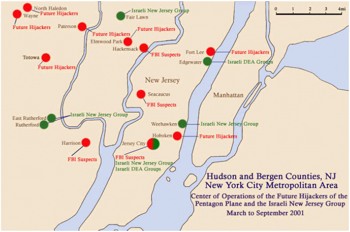
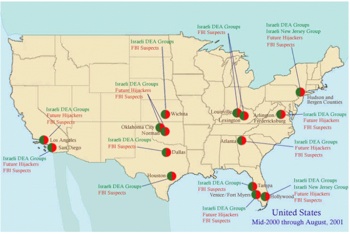
All righty then. That's a lot of heady stuff to consider. I'll note again that I am not a true believer in anything in today's post. I just want to offer some of the interesting things out there on the internet today. I strongly believe that the Republican establishment in America today is very complicit in international drug trafficking – especially since we've got a lot of the same guys who ran cocaine angles in Central America during the Iran-Contra affair. Past behavior is a guide towards future actions, if not ironclad proof.
Arbitrage is power: the buying and selling of goods across geographic space supports the global "shadow economy" that makes up a huge proportion of economic activity. Whoever controls the space, controls the money. Half of Afghanistan's economy is heroin production, for example. Follow the cash: it's one heck of a loose end of September 11, and the war on terror.
Now that the dust is settling, we are hearing reports from the field about what exactly Hezbollah was doing down in South Lebanon. For more military analyses look at this excellent thread on Agonist.org Lessons Learned. Guys like William Lind have good stuff too.
For the moment, we are going to post a big chunk of Anthony Cordesman's summary of the whole damn thing. The press conference is here (PDF), the actual doc is here.
Center for Strategic and International Studies
1800 K Street, N.W. • Suite 400 • Washington, DC 20006
Phone: 1 (202) 775-3270 • Fax: 1 (202) 457-8746
Web: http://www.csis.org/burke/
Preliminary “Lessons” of the Israeli-Hezbollah War (PDF)
Anthony H. Cordesman, Arleigh A. Burke Chair in Strategy acordesman@aol.com
Working Draft for Outside Comment, Revised: August 17, 2006
[Page 16]....
Lessons and Insights into Various Tactical,
Technological, and Other Military Aspects of the War
Once again, it is important to stress that many key details of the tactics, technology, and
other aspects of the fighting are not yet clear. There are, however, several additional
lessons that do seem to emerge from the conflict.
High Technology Asymmetric Warfare
There is virtually no controversy over whether the fighting with the Hezbollah shows just
how well a non-State actor can do when it achieves advanced arms, and has strong
outside support from state actors like Iran and Syria. Top-level Israeli intelligence
personnel and officers stated that most aspects of the Hezbollah build-up did not surprise
them in the six years following Israel’s withdrawal in Lebanon.
Mosad officials stated that they had tracked the deployment of some 13,000 Katyushas,
far more sophisticated Iranian medium and long-range artillery rockets and guided
missiles (Zelzal 3), better surface-to-air missiles like the SA-14, SA-16, and possibly SA-
8 and SA-18, the CS-801 anti-ship missile, and several more capable anti-tank weapons
like the AT-3 Sagger Two and Kornet. They also identified the armed UAV the
Hezbollah used as either the Iranian Mirsad-1 or Ababil-3 Swallow.
Israeli intelligence officials also stated that they knew some 100 Iranian advisors were
working with the Hezbollah, and that they knew Iran not only maintained high volumes
of deliveries, but also had created a Hezbollah command center for targeting and
controlling missile fire with advanced C2 assets and links to UAVs. They noted that they
had warnings of better sniper rifles, night vision devices, and communications as well as
of technical improvements to the IEDs, bombs, and booby traps that the Hezbollah had
used before the Israeli withdrawal.
Israeli officials and officers were not consistent about the scale or nature of the
technology transfer to the Hezbollah or of how many weapons they had. In broad terms,
however, they agreed on several points.
Hezbollah Rocket and Missile Forces
Israel faced a serious local threat from some 10,000-16,000 shorter-range regular and
extended range versions of the Kaytusha. These are small artillery rockets with individual
manportable launchers. The rockets have small warheads and ranges of 19-28 kilometers
(12-18 miles) that can only strike about 11-19 kilometers (7-12 miles) into Israel unless
launched right at the border. They can easily be fired in large numbers from virtually any
position or building, and the Hezbollah had a limited capacity for ripple fire that partly
made up for the fact that such weapons were so inaccurate that they hit at random, could
only be aimed at town-sized targets, and had very small warheads. They were, however,
more than adequate to force substantial evacuations, paralyze local economic activity,
and drive the Israelis that remained to shelters.
Israeli officers and officials made it clear that Israel’s real reason for going to war,
however, was the steady deployment of medium and longer range systems, and the
potential creation of a major Iranian and Syrian proxy missile force that could hit targets
throughout Israel.
This force included Syrian 220mm rockets and systems like the Fajr 3, with ranges of 45-
75 kilometers, capable of striking targets as far south as Haifa and Naharia. The IAF was
able to destroy most of the Iranian Fajr 3 launchers the first night of the war, but the IDF
did not know the Syrian rockets were present.
The Fajr 3, or Ra’ad, has a range of 45 kilometers, a 45-kilogram warhead, a 240-mm
diameter, a 5.2-meter length, and a weight of 408 kilograms.
A total of some 24-30 launchers and launch vehicles, carrying up to 14 rockets each, seem to have been present.
The IAF feels it destroyed virtually all launchers that fired after the first few days, but
Israeli officers did not provide an estimate of how many actually survived.
They also included the Syrian 302-mm artillery rockets and Fajr 5, with ranges of 75 and
higher kilometers. The IAF again feels that it was able to destroy most of the Iranian Fajr
5 launchers the first night of the war, but the IDF again did not know the Syrian 302-mm
rockets were present.
The Fajr 5 is launched from a mobile platform with up to four rockets per launcher, and
has a maximum range of 75 kilometers, a 45-kilogram warhead, a 333-mm diameter, a
6.48-meter length, and a weight of 915 kilograms.
A total of some 24-30 launchers and launch vehicles seem to have been present. Again, the IAF feels it destroyed virtually all
launchers that fired after the first few days, but Israeli officers did not provide an estimate
of how many actually survived.
The level of Hezbollah capabilities with the Zelzal 1, 2, and 3 and other possible systems
has been described earlier. These missiles have ranges of 115-220 kilometers. The Zelzal
2 is known to be in Hezbollah hands and illustrates the level of technology involved. It is
a derivative of the Russian FROG 7, and has a range in excess of 115 kilometers. It has a
610-mm diameter, a 8.46-meter length, and a weight of 3,545 kilograms.
It requires a large TEL vehicle with a large target signature.
Anti-Ship Missiles
The Hezbollah C-802 missile that damaged an Israeli Sa’ar 5, one of Israel’s latest and
most capable ships, struck the ship when it was not using active countermeasures. It may
or may not have had support from the coastal radar operated by Lebanese military fires
destroyed by IAF forces the following day.
According to Global Security, the Yingji YJ-2 (C-802) is powered by a turbojet with
paraffin-based fuel. It is subsonic (0.9 Mach), weighs 715 kilograms, has a range 120
kilometers, and a 165 kilogram (363 lb.). It has a small radar cross section and skims
about five to seven meters above the sea surface when it attacks the target. It has good
anti-jamming capability.
Anti-Armor Systems
The IDF faced both older anti-tank guided missile (ATGM) threats like the AT-3 Sagger,
AT-4 Spigot, and AT-5 Spandrel—each of which is a wire-guided system but which
become progressively more effective and easier to operate as the model number
increases.
The IDF also faced far more advanced weapons like the Russian AT-13 Metis-
M which only requires the operator to track the target, and the AT-14 Kornet-E, a third
generation system, that can be used to attack tanks fitted with explosive reactive armor,
and bunkers, buildings, and entrenched troops. Many of these systems bore serial
numbers that showed they came directly from Syria, but others may have come from Iran.
The AT-14 is a particularly good example of the kind of high technology weapon the US
may face in future asymmetric wars. It can be fitted to vehicles or used as a crew-portable
system.
It has thermal sights for night warfare and tracking heat signatures, and the
missile has semi-automatic command-to-line-of-sight laser beam-riding guidance. It flies
along the line of sight to engage the target head-on in a direct attack profile. It has a
nominal maximum range of 5 kilometers. It can be fitted with tandem shaped charge
HEAT warheads to defeat tanks fitted with reactive armor, or with high
explosive/incendiary warheads, for use against bunkers and fortifications. Maximum
penetration is claimed to be up to 1,200mm.
Other systems include a greatly improved version of the 105.2-mm rocket-propelled
grenade called the RPG-29 or Vampire. This is a much heavier system than most
previous designs. It is a two-man crew weapon with a 450-meter range, and with an
advanced 4.5-kilogram grenade that can be used to attack both armor and bunkers and
buildings. Some versions are equipped with night sights.
The IDF saw such weapons used with great tactical skill, and few technical errors,
reflecting the ease with which third generation ATGMs can be operated. They did serious
damage to buildings as well as armor. The Hezbollah also showed that it could use the
same “swarm” techniques to fire multiple rounds at the same target at the same time often
used in similar ambushes in Iraq. As of August 11th, however, a total of 60 armored
vehicles of all types (reports these were all tanks are wrong) had been hit. Most continued
to operate or were rapidly repaired in the field and restored to service. Only 5-6 of all
types represented a lasting vehicle kill.
Anti-Aircraft
The IDF estimates that the Hezbollah at least have the SA-7 and SA-14 manportable
surface-to-air missile system, probably have the SA-16, and may have the SA-18. The
SA-14 and SA-16 are much more advanced than the SA-7, but still possible to counter
with considerable success. The SA-18 Grouse (Igla 9K38) is more problematic.
According to the Federation of American Scientists, it is an improved variant of the SA-
14 that uses a similar thermal battery/gas bottle, and the same 2 kilogram high-explosive
warhead fitted with a contact and grazing fuse. The missile, however, is a totally new
design and has much greater operational range and speed. It has a maximum range of
5200 meters and a maximum altitude of 3500 meters, and uses an IR guidance system
with proportional convergence logic, and much better protection against electro-optical
jammers.
It is possible that it may have been given a few SA-8 Gecko (Russian 9K33 Osa) SAM
systems that are vehicle mounted, radar-guided systems with up to a 10-kilomter range,
and six missiles per vehicle.
The IDF is concerned that these systems would allow the Hezbollah to set up “ambushes”
of a few IAF aircraft without clear warning—a tactic where only a few SA-8s could
achieve a major propaganda victory. This concern, coupled to the risk of SA-16 and SA-
18 attacks, forced the IAF to actively use countermeasures to an unprecedented degree
during the fighting.
Low Signature; Asymmetric Stealth
One key aspect of the above list is that all of the systems that are not vehicle-mounted
are low signature weapons that very difficult to characterize and target and easy to bury
or conceal in civilian facilities. Stealth is normally thought of as high technology. It is
not. Conventional forces still have sensors geared largely to major military platforms and
operating in environments when any possible target becomes a real target. None of these
conditions applied to most Hezbollah weapons, and the problem was compounded by the
fact that a light weapon is often easier to move and place without detection in a built-up
area than a heavy one.
This signature issue applies to small rockets like the Qassam and Kaytusha that require
only a vestigial launcher that can be place in a house or covert area in seconds, and fired
with a timer. Israeli video showed numerous examples of Hezbollah rushing into a home,
setting up a system, and firing or leaving in a time in less than a minute.
It also applies to UAVs. Israel’s normal surveillance radars could not detect the Iranian
UAVs, and the IDF was forced to rush experiments to find one that could detect such a
small, low-flying platform. (This may be an artillery counterbattery radar but Israeli
sources would not confirm this.)
Technological Surprise
Israeli officers and experts did indicate that the IDF faced technological surprise and
uncertainty in some areas.
Syria evidently supplied nearly as many medium range artillery rockets—220 mm and
302 mm—as Iran, and a major portion of the Katyushas. The RPG-29 anti-tank weapon
and possible deployment of more advanced anti-tank guided weapons was not
anticipated. It was not possible to determine how advanced the surface-to-air missiles
going to Hezbollah forces were. It was not possible to determine the exact types and level
of capability for Iran’s long-range missile transfers because the three types of Zelzal are
so different in performance, and other Iranian systems (including ones with much better
guidance) are similar to what Israel calls the Zelzal 2 and 3.
The fact Israel faced some degree of technological surprise should not, however, be a
source of criticism unless there is evidence of negligence. If there is a lesson to be drawn
from such surprise, it is that it is almost unavoidable when deliveries are high and many
weapons are small and/or are delivered in trucks or containers and never seen used in
practice.
It is even more unavoidable when rapid transfer can occur in wartime, or new facilities
are created, such as the joint Iranian-Syrian-Hezbollah intelligence (and advisory?) center
set up during the fighting in Damascus to give the Hezbollah technical and tactical
intelligence support. The lesson is rather that the war demonstrates a new level of
capability for non-state actors to use such weapons.
Cost
The US and Israel quote figures for the cost of these arms transfers that can reach the
billions, and talk about $100-$250 million in Iranian aid per year. The fact is that some
six years of build-up and arms transfers may have cost closer to $50-$100 million in all.
The bulk of the weapons involved were cheap, disposable or surplus, and transfers put no
strain of any kind on either Syria or Iran.
This is a critical point, not a quibble. Playing the spoiler role in arming non-state actors
even with relatively advanced weapons is cheap by comparison with other military
options. The US must be prepared for a sharp increase in such efforts as its enemies
realize just how cheap and easy this option can be.
Reevaluating the Level of Tactical and Technological Risk in the Forces of
Asymmetric and Non-State Actors
Experts like Sir Rupert Smith have already highlighted the risk posed to modern military
forces and states by opponents that fight below the threshold in which conventional
armies are most effective. Iraq has shown that even comparatively small transfers of
technology like motion sensors, crude shaped charges, and better triggering devices can
have a major impact in increasing the ability of insurgents and terrorists.
The Hezbollah have raised this to a whole new level, operating with effective sanctuary
in a state and with major outside suppliers—which Al Qa’ida has largely lacked. It is also
only the tip of the iceberg. It does not seem to have used the advanced SAMs listed
above, but the very threat forces IAF fighters and helicopters to constantly use
countermeasures. The use of ATGMs and RPG-29 not only inhibits the use of armor, but
sharply reduces the ability to enter buildings and requires dispersal and shelter.
The simple risk of long-range rocket attacks requires constant air and sensor coverage in
detail over the entire Hezbollah launch front to be sure of hitting launchers immediately.
The IDF’s task also could grow sharply if Iran/Syria sent the Hezbollah longer-range
rockets or missiles with precision guidance—allowing one missile to do serious damage
to a power plant, desalination plant, refinery/fuel storage facility with little or no warning.
The lesson here is not simply Hezbollah tactics to date. It is the need to survey all of the
weapons systems and technology that insurgents and terrorists could use in future strikes
and wars with the thesis that technology constraints are sharply weakening, and the US
and its allies face proliferation of a very different kind. It is to explore potential areas of
vulnerability in US forces and tactics non-state or asymmetric attackers can exploit,
carefully examine the holdings of state sponsors of such movements, and reexamine web
sites, training manuals, etc, to track the sharing or exploration of such technology.
Like Israel, the US and its other allies face long wars against enemies that have already
shown they are highly adaptive, and will constantly seek out weaknesses and the ability
to exploit the limits to conventional warfighting capabilities. The US must anticipate and
preempt when it can, and share countermeasure tactics and technologies with its allies.
Informal Networks and Asymmetric "Netcentric Warfare"
Like insurgent and terrorist groups in Iraq and Afghanistan—and in Arab states like
Algeria, Egypt, Saudi Arabia, and other states threatened by such groups—the Hezbollah
showed the ability of non-state actors to fight their own form of netcentric warfare. The
Hezbollah acted as a "distributed network" of small cells and units acting with
considerable independence, and capable of rapidly adapting to local conditions using
media reports on the, verbal communication, etc.
Rather than have to react faster than the IDF's decision cycle, they could largely ignore it,
waiting out Israeli attacks, staying in positions, reinfiltrating or reemerging from cover,
and choosing the time to attack or ambush. Forward fighters could be left behind or
sacrificed, and "self-attrition" became a tactic substituting for speed of maneuver and the
ability to anticipated IDF movements.
Skilled cadres and leadership cadres could be hidden, sheltered, or dispersed. Rear areas
became partial sanctuaries in spite of the IDF. Aside from Nasrallah, who survived, no
given element of the leadership cadre was critical.
A strategy of attrition and slow response substituted for speed and efficiency in command
and control. The lack of a formal and hierarchical supply system meant that disperse
weapons and supplies—the equivalent of "feed forward logistics"—accumulated over six
years ensured the ability to keep operating in spite of IDF attacks on supply facilities and
resupply.
The ability to fight on local religious, ideological, and sectarian grounds the IDF could
not match provided extensive cover and the equivalent of both depth and protection. As
noted earlier, civilians became a defensive weapon, the ability to exploit civilian
casualties and collateral damage became a weapon in political warfare, and the ability to
exploit virtually any built up area and familiar terrain as fortresses or ambush sites at
least partially compensated for IDF armor, air mobility, superior firepower, and sensors.
The value and capability of such asymmetric "netcentric" warfare, and comparatively
slow moving wars of attrition, should not be exaggerated. The IDF could win any clash,
and might have won decisively with different ground tactics. It also should not be
ignored. The kind of Western netcentric warfare that is so effective against conventional
forces has met a major challenge and one it must recognize.
Well that sounds like some badass shit. More later, but for now, dig the asymmetrical networkality of the low apogee swarm missile strategy. It delivers the goods!
The test of the Zionist left. By Yossi Beilin (Haaretz)
There are those who expect the Zionist left to join in the revelry of war, in the pathetic slogans such as "We will win" and in the fiery comments such as "Nasrallah will remember who Amir Peretz is."
There are those who expect us to join the non-Zionist left, which is calling for a unilateral cease-fire, accuses Israel of war crimes, demands that Hamas and Hezbollah be given what they want, and opposes all use of force. Both sides say this is the test of the Zionist left - and they are right.
We have a deep belief in the right of the Jewish people to a democratic and secure state, which has a stable Jewish majority: the state of the Jewish people and all of its citizens. We are convinced our national interest is in completing the moves toward peace with the Palestinians, Syria and Lebanon, and that there is no alternative to an agreement.
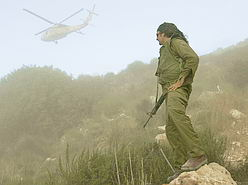 I am not gonna feel like writing tomorrow, so it's either now or the weekend. Here are a lot of bits from the past couple weeks in the Lebanon-Israel conflict. The window after the first two weeks was Israel's chance to capture the initiative against Hezbollah and attempt to achieve their hazily articulated goals in this vicious little war. It's a big war, but the space is very small.
I am not gonna feel like writing tomorrow, so it's either now or the weekend. Here are a lot of bits from the past couple weeks in the Lebanon-Israel conflict. The window after the first two weeks was Israel's chance to capture the initiative against Hezbollah and attempt to achieve their hazily articulated goals in this vicious little war. It's a big war, but the space is very small.
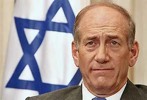 Escalations for the weekend: Haaretz: Security cabinet okays decision to expand ground operation in Lebanon:
Escalations for the weekend: Haaretz: Security cabinet okays decision to expand ground operation in Lebanon:
.......PM wavered on expansion decision
Olmert was hesitant prior to the meeting on whether to approve the proposed expansion of the IDF ground operation in south Lebanon.
Olmert was concerned that the plan presented by the defense establishment would result in hundreds of casualties, and therefore, wanted to subject it to a careful cost-benefit analysis. In Tuesday's fighting in Lebanon five soldiers were killed and 23 others wounded, two of them seriously. According to a government source, Olmert had also asked the army to present him with several different options for a ground operation.
A decision to send troops deeper into Lebanon is fraught with considerable risk. In doing so, Israel could set itself up for new criticism that it is sabotaging diplomatic efforts. Also, a wider ground offensive might do little to stop Hezbollah rocket fire on Israel, while sharply increasing the number of casualties among Israeli troops.
While most of the cabinet was expected earlier to back whatever Olmert decides, sources in the Prime Minister's Office said that three to four ministers were likely to oppose a large-scale ground operation regardless of Olmert's position. The IDF's proposal was for a two-week ground operation that would involve conquering the entire area south of the Litani River, and even a few areas north of it, in order to reduce Hezbollah's short-range rocket launching capabilities.
IDF Chief of Staff Dan Halutz said Tuesday that such an operation was necessary "in order to end this war differently." People who participated in discussions of the plan with him said they had never heard him speak as forcefully in favor of anything as he did in favor of the proposed ground operation. Peretz fully supports the army's plan, which he considers essential for Israel to achieve its diplomatic goals.
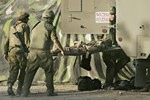 Nine paratroopers killed in attack on home in Dibel; 15 soldiers killed Wednesday in south Lebanon
Nine paratroopers killed in attack on home in Dibel; 15 soldiers killed Wednesday in south Lebanon
By Amos Harel and Eli Ashkenazi, Haaretz Correspondents, and Agencies Last update - 01:59 10/08/2006
Fifteen Israel Defense Forces troops were killed on Wednesday, the IDF announced late Wednesday night, as fierce fighting with Hezbollah guerillas raged in the southern Lebanon villages of Ayta al-Shaab and Debel.
The 15 IDF soldiers were killed in a series of firefights across the front. In the most serious incident, nine reserve paratroopers were killed and 11 wounded by antitank missiles fired on a house in the village of Debel, in the central sector. Four reservists from an armored brigade were killed in a tank explosion, apparently caused by antitank missiles, in the town of Ayta al-Shaab. An infantryman was killed late Wednesday when he was hit by a mortar in Marjayoun.
DEBKAFile: Israeli official spokesman say deep ground push into Lebanon approved Wednesday to reduce rocket attacks is put on hold for 48 hours to give more time for diplomacy August 10, 2006, 9:26 AM (GMT+02:00)
DEBKAfile adds: On the ground, the first troop and tank elements of the advance began moving Wednesday overnight and are continuing Thursday, Aug. 10.
The decision Wednesday, Aug. 9, by 9 votes, none against and 3 abstentions, includes areas up to the Nabatea plateau and Arnoun beyond the Litani River. The objectof the extension is to reach and eliminate Hizballah's rocket-launch centers. It deepens Israel's thrust to some 45 km from the border and calls for a further large influx of army reserves.
DEBKAfile’s military sources add the extended operation does not promise the total stoppage of all rocket fire against Israel, but could potentially bring about a sizeable reduction from up to 200 a day to some 30 or 50.
Also: The stakes of the Lebanon War have shot up with the expansion of the Israeli offensive up to the Litani and Nasrallah’s rejection of diplomacy in favor of battle
Israel's military of old was specialized in quick, mechanized warfare. As they settled into the occupied territories, despite all the heavy weapons, the IDF reoriented itself to battling Palestinians, typically armed with rifles, handguns or machine guns. The Palestinians have some rocket-propelled grenades, as well, but they lack advanced infantry weapons. So the IDF has phased away from preparing for war with real infantries, and instead play supercop on the hapless residents of the West Bank.
They really thought that Hezbollah was only as "thick" as HAMAS, I guess. The Israelis went storming in without realizing that Hezbollah had lots of anti-tank missiles - on rocky terrain that doesn't give a lot of space for tanks. The IDF doctrine failed in the face of a new kind of conflict.
Right now we are watching a turning point in the nature of warfare. Everything from pack mules to to hacking to encrypted satellite feeds fits into fourth-generation warfare (pdf). Sub-state actors will basically be able to fight a top-notch modern army.
ANALYSIS: IDF still not in control of strip along Lebanon's border By Ze'ev Schiff, Haaretz Correspondent 08:57 10/08/2006
The large number and the location of the casualties that the Israel Defense Forces sustained Wednesday indicate that the army does not yet control the narrow strip along the border, although this stage of the ground operation was supposed to have been completed already.
The two battles also reveal a great deal about Hezbollah's method of fighting. They took place in two relatively small communities, Ayta al-Shab and Debel, close to the international border, on territory that until May 2000 was in Israel's Security Zone.
The ground operation, dubbed "Change of Direction 8," was intended to conquer this border strip. First it was to be a two- to three-kilometer strip. Then it was expanded to five to six kilometers, including numerous Lebanese villages and towns. The mission was to blow up all Hezbollah's outposts in this strip and drive its forces out.
What happened in Bint Jbail recurred in Ayta al-Shab. Although it seemed that the town had been conquered, it transpired again and again that there were still Hezbollah men in it. Once again, clashes and battles took place, and again, the IDF suffered dead and wounded. Although the army had conquered the town, Hezbollah men were hiding in underground bunkers well camouflaged from the outside. The bunkers had been stocked with large quantities of food, enough to last for weeks, and ammunition, including antitank missiles and, in several cases, short-range rockets.
The bunkers are connected to electricity and, according to one report, are air conditioned. When the fighting dies down, Hezbollah fighters emerge from the bunkers and set up ambushes for IDF soldiers and armored vehicles. That is why soldiers are hit repeatedly in the same places.
On several occasions, there have been difficulties evacuating wounded soldiers under fire. At times, Hezbollah fighters have fired rockets at Israel from areas close to the border that the IDF had supposedly conquered already. The means available to flush the guerrillas out of their underground shelters are not always employed.
Senior officers have suggested, inter alia, that the army bombard these towns heavily and even destroy them. But in any case, a decision has been made not to reenter them at this stage. The IDF could forge ahead, as it has done in the last two days in the Marjayoun area. But even after such an incursion, Hezbollah fighters who remain in the bunkers could continue launching rockets. In other words, they could fire toward Israel from behind the lines of IDF forces that have progressed deep into Lebanon. It is clear that the Hezbollah men who stayed behind are equipped with two-way radios and receive information from scouts hiding near the border. This explains the difficulties in managing the fighting in south Lebanon, which the IDF has not encountered before.
Even if Hezbollah "loses", the writing is on the wall. In the 21st century "the State" itself is weakening. Sub-national organizations like Hezbollah, with economic, military, political, social, educational, medical (and often spiritual) branches are displacing the State.
One should remember that the Middle East's artificial European-drawn boundaries have left many overlapping ethnic groups. The Pashtuns now at the core of the Taliban straddle Afghanistan/Pakistan. The Kurds are organized a bit like Hezbollah, and the ruthless pursuit of the Kurds' interests has rewarded them well since the US toppled Saddam. But they too are divided between parties that ruthlessly fight each other.
In Syria, only a few dozen miles east of Israel's bombing campaign lie many major Arab Sunni tribes like the Dulaimis, who especially live in cities along the river into Iraq, where their cousins' tribes live, sparring with Kurds and Shiites.
In this kind of region, everyday people are going to direct their primary loyalties towards sub-national groups that they believe represent their interests. By the early 1990s, Hezbollah, which the Iranians helped create by binding together different Lebanese Shiites, was seen as something of a successful model – social, political, military: robustly structured to resist political pressure, infiltration and military assaults from the Israelis and others.
Before Saddam fell, The Iranians used the Lebanese sub-state model inside Iraq, to lay the framework for the Shiite rise to power. Very quickly, SCIRI, Muqtada Sadr's people, and the Dawa Party all had organized cadres of armed guys, but more importantly, social services and methods for trying to restore any sense of law and order shattered with the US invasion. If the guys on the block with guns keep the thieves away, then they are pretty much your state, even if they don't report to Baghdad.
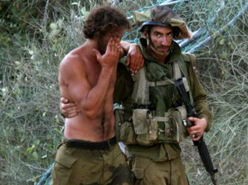 The news in Israel right now is that 15 reservists got killed in Lebanon, with heavy fighting around Bint Jbail, a site the IDF captured and subsequently evacuated. As the maps made clear, Bint Jbail is not more than a few kilometers from the border, yet the Israeli forces, despite all the bombing and everything, have not been able to hold that area, once they reached it and tried to occupy.
The news in Israel right now is that 15 reservists got killed in Lebanon, with heavy fighting around Bint Jbail, a site the IDF captured and subsequently evacuated. As the maps made clear, Bint Jbail is not more than a few kilometers from the border, yet the Israeli forces, despite all the bombing and everything, have not been able to hold that area, once they reached it and tried to occupy.
Reports in the Israeli media indicate that Hezbollah is able to keep attacking in areas the Israelis have already 'captured.' I think it's pretty likely that Hezbollah has drilled tunnels hundreds, if not thousands of meters long, attached to deeply hidden bunkers with all the necessary weapons and supplies. It is an amazing intelligence failure that the Israelis didn't anticipate this, and still, within a very small space the IDF has not been able to block out Hezbollah. The tempo of rocket attacks has not been curtailed in any serious way, and Israeli military analysts don't really think it can be shut down without a wide invasion. Hezbollah is winning the tactical situation by playing very hard-core defense with lots of anti-tank missiles. So far, it's mostly been a successful military strategy.
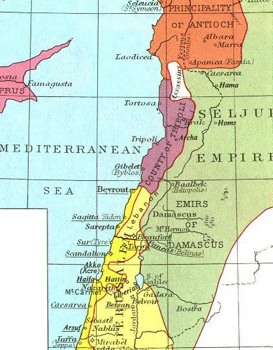 This is in keeping with the local style: in the good old days of the Seljuk Empire (c. 1100), the Hashshashin, or Assassins, would hang out somewhere between Damascus and Antioch - the home of the Holy Hand Grenade. The map's white spot shows a patch of mountainous land where the Assassins held sway. Mountainous redoubts are easier to defend, and such clever methods have migrated about 200 miles south, where nearly a millennia later, some pretty insane shit is going down.
This is in keeping with the local style: in the good old days of the Seljuk Empire (c. 1100), the Hashshashin, or Assassins, would hang out somewhere between Damascus and Antioch - the home of the Holy Hand Grenade. The map's white spot shows a patch of mountainous land where the Assassins held sway. Mountainous redoubts are easier to defend, and such clever methods have migrated about 200 miles south, where nearly a millennia later, some pretty insane shit is going down.
Well then, thats enough rambling background. Here's some damn links.
The rockets keep coming: Hizbollah rockets kill 15 in northern Israel. Hapless reservists. An ugly scene. IDF Raids near Tyre.
Emotional reaction in Israel propels poor policy:
`Peace' is a term not used in the public space in Israel anymore...No one expects any dialogue on a real practical level. The military always offers a shortsighted immediate way out. The wish to identify with the power of the gun and the uniform is still alive in Israeli tribal DNA. Revenge is a word not used in the open; it is there in the undercurrent of the emotions expressed by the public, our bombardment of Gaza had the same motive behind it.
UK Guardian: Israeli pilots 'deliberately miss' targets: Fliers admit aborting raids on civilian targets as concern grows over the reliability of intelligence
You need to give money to AntiWar.com. Their work is important and kinda spooky. Rumors that apocalyptic Christian writers are visiting the White House. Stratfor has free podcasts. Updates on the Tikkun Olam blog (תקון עולם: Make the World a Better Place).
Iranian dimensions:
Haaretz: Nasrallah's dilemma By Amos Harel and Avi Issacharoff
As the war progresses, the depth of Iranian involvement in Hezbollah activity is increasingly being revealed. Hezbollah has established a Tehran-sponsored forward outpost here, under the noses of the Israelis. When the war ends, Iranian soul-searching will include the question as to whether the activity here was not premature: whether the strategic card of the rocket battery was not revealed too early, for the sake of a negligible goal like the release of the four prisoners, instead of saving it for the day of judgment, for the eruption surrounding its nuclear program.
The Iranians are involved up to their necks in Hezbollah activity: Their advisers participated in the firing of the missiles at Israeli ships and in the firing of Strela (SA-7) antiaircraft missiles at Israeli planes and helicopters. During Israel Defense Forces operations in the south, sophisticated listening rooms were discovered, via which the Iranians eavesdropped on Israeli communications and telephone networks, both civilian and military.
Guardian: Bloody night in Beirut as Israel intensifies aerial bombardment: IDF warns UN troops will be attacked if they repair bridges (aug 8)
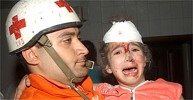 Information warfare sector: Olmert meets with spokespeople to sharpen PR message. PrisonPlanet says: Another Israeli Myth Exposed: There Were No Hezbollah Rockets In Qana but Israeli media alleges Qana killing was staged, dubbing this pattern Hezbollywood. With a certain sense of weird horror, Haaretz features "Where there's smoke, there's liars": "1. The Muslim Lie Mode, or The Dead as Visual Aid (When Arabs report what Israel has done) 2. The Israeli Lie Mode, or The Dead as Enemy Weapon (When Israelis report what Israel has done). 3. The American Lie Mode, or The Dead as Nonexistent." Anyway, Half of U.S. Still Believes Iraq Had WMD.
Information warfare sector: Olmert meets with spokespeople to sharpen PR message. PrisonPlanet says: Another Israeli Myth Exposed: There Were No Hezbollah Rockets In Qana but Israeli media alleges Qana killing was staged, dubbing this pattern Hezbollywood. With a certain sense of weird horror, Haaretz features "Where there's smoke, there's liars": "1. The Muslim Lie Mode, or The Dead as Visual Aid (When Arabs report what Israel has done) 2. The Israeli Lie Mode, or The Dead as Enemy Weapon (When Israelis report what Israel has done). 3. The American Lie Mode, or The Dead as Nonexistent." Anyway, Half of U.S. Still Believes Iraq Had WMD.
The US-Israeli link: this looks at Condi and an IDF spokesperson as two flipsides: Between two friends by Tom Segev:
During the past 39 years since the Six-Day War, the United States did not force Israel to pull out of the West Bank, but more than once acted to block Israeli military actions. Over time, we have grown accustomed to the Americans saving us, not only from the Arabs, but from ourselves too. Not in this war. It is still unclear whether this war was coordinated with the United States; only the release of government records of the past three weeks will shed light on this. Whatever the case may be, the impression is that the Americans are linking the events in Lebanon to their failing adventure in Iraq.
Israel's elites, in all fields, are made up of people who spent a number of years in the United States and returned with not only professional skills but also an appreciation for the value of the individual and basic freedoms. For the most part, this was a useful process, even though it did contribute to a fading of social compassion. This process of Americanization has led Israel in recent years to covet a role in what Bush has described as a war on the "axis of evil."
As such, Israel has adopted the moral values of Hezbollah: Whatever they are doing to the residents of northern Israel, we can also do to the citizens of Lebanon, and even more. Many Israelis tended to look at the Qana incident primarily as a media disaster and not as something that imposed on them any ethical responsibility. After all, the restrictions of humanitarian warfare are not applicable to the "axis of evil." Just like in Iraq, the lessons of Vietnam have been forgotten. It is hard to avoid the impression that the routine brutality of oppression in the Gaza Strip and the West Bank is also reflected in the unbearable ease with which Israel has forced out of their homes hundreds of thousands of Lebanese and bombed civilians.
Tense situation with Israel's own Arab population (20%): Border Police search Israeli Arab homes without warrants.
Loss of Momentum by Amir Oren (Haaretz):
The IDF's greatest loss was momentum. The first week of the campaign went reasonably well, borne on the wave of the stunning success of the attack of Hezbollah's long-range rockets. Between the middle of the second week and the middle of the third week the IDF lost a week, not least because of its reaction to the eight Golani Brigade soldiers who were killed in Bint Jbail. That lost week, as the rain of Katyusha rockets continued to fall from on high, undermined the army's self-confidence and thrust it into a posture of public self-defense. It shifted into recovery mode only because of the time it was granted by Washington. Fear of a large number of casualties was the major factor in the government's hesitations, for almost a week, about whether to send more divisions into the fray, entailing a call-up of reserve units.
The General Staff admitted the IDF did not work fast enough. They did not grasp the fact that the context had changed and that this was not just one day of battle or a routine-security incident, but a war, which has its own laws. Commanders who were used to operations in the territories did not internalize the need for speed, persistence and continuity.....
The sweeping criticism did an injustice to Division 91 and to the "hunt" concept in the air force. A colonel in the division said this week that for months the division's senior command "drove officers crazy with alerts to prevent abductions, turned over every stone and laid down new stones in order to turn them over, too." The abduction, the colonel noted, was comparable to a special operation by an IDF commando unit, which, in the absence of precise intelligence, is difficult to thwart even after all the preparations across the sector.
Various people yelling at each other: ADL: Hugo Chavez comparison of IDF and Hitler is Outrageous. Yesha (settler) Rabbinical Council objects to ridicule of Chief IDF Rabbi.
Hawks crow: Win that war! (Haaretz). Peace Index: July 2006 / Support for the war and the IDF holds up.
A final batch: I got nothing left after these Haaretz bits: ANALYSIS: There appears to be a command problem in the north. From war, an opportunity. Snatch a possible victory. Down but not out. Little Satan has big teeth. ANALYSIS: Deployment of Lebanese army may be good for both sides.
Well, that's all for a while. Enjoy.